小升初英语总复习-词类-1、名词课件(49张幻灯片)
文档属性
| 名称 | 小升初英语总复习-词类-1、名词课件(49张幻灯片) | 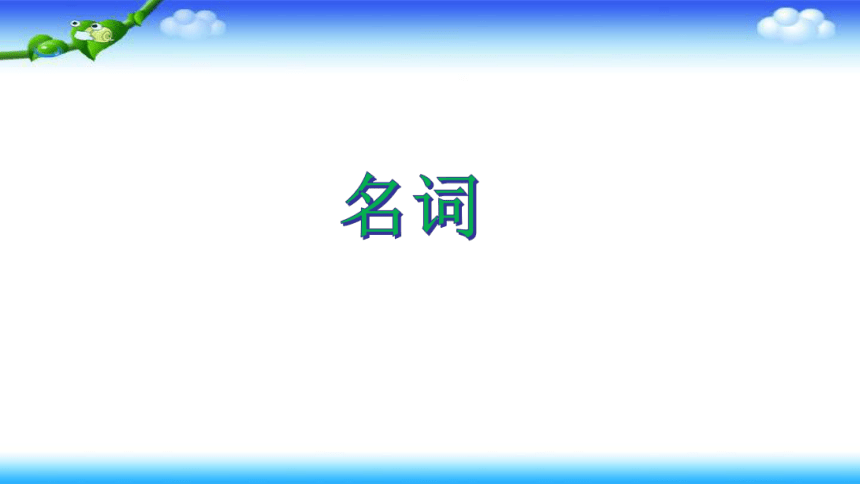 | |
| 格式 | pptx | ||
| 文件大小 | 235.6KB | ||
| 资源类型 | 教案 | ||
| 版本资源 | 人教版(PEP) | ||
| 科目 | 英语 | ||
| 更新时间 | 2021-03-17 19:35:31 | ||
图片预览

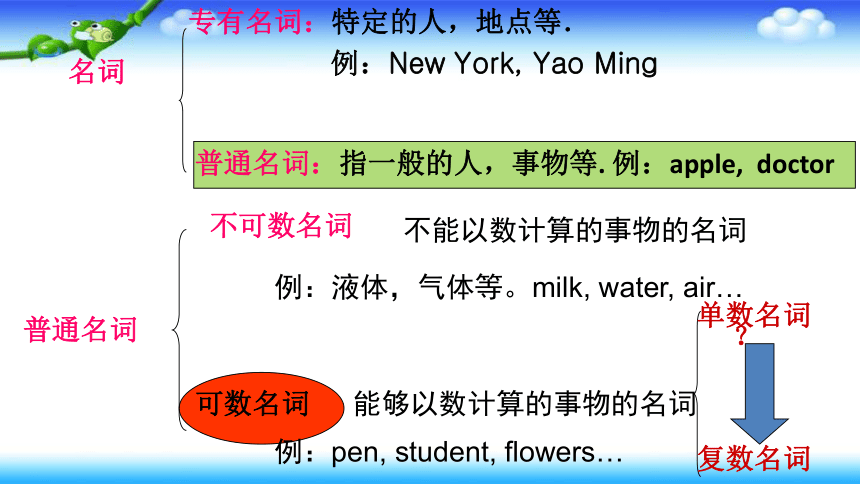
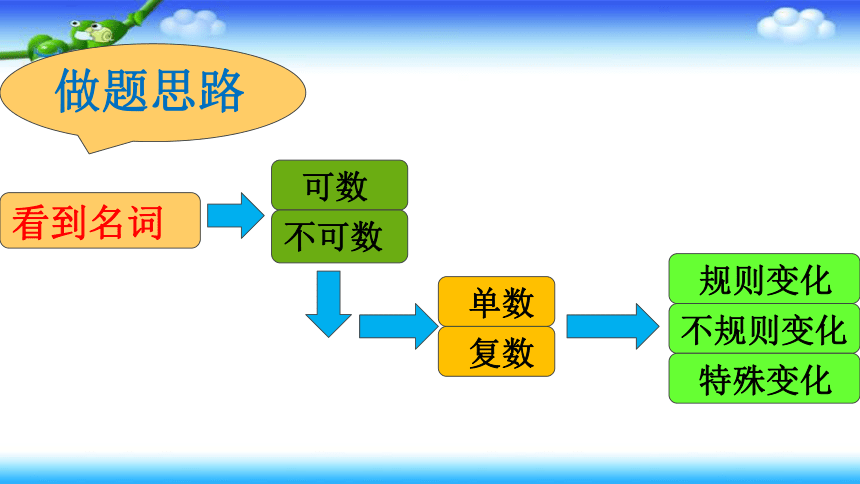
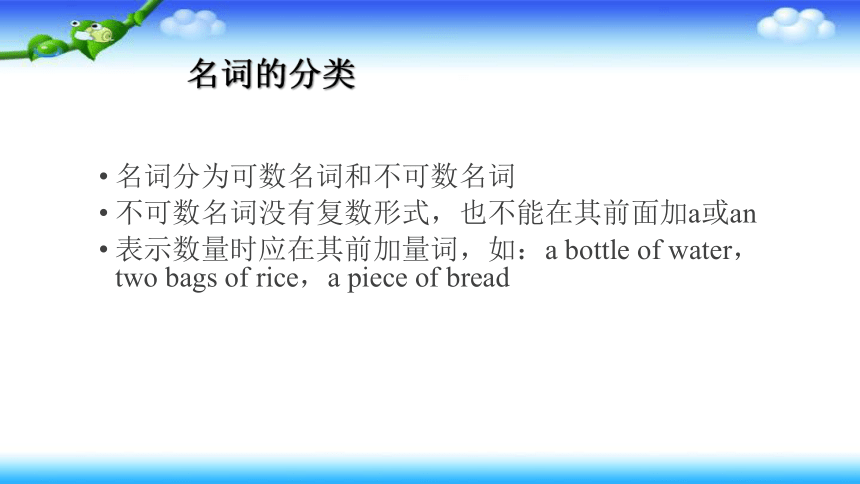
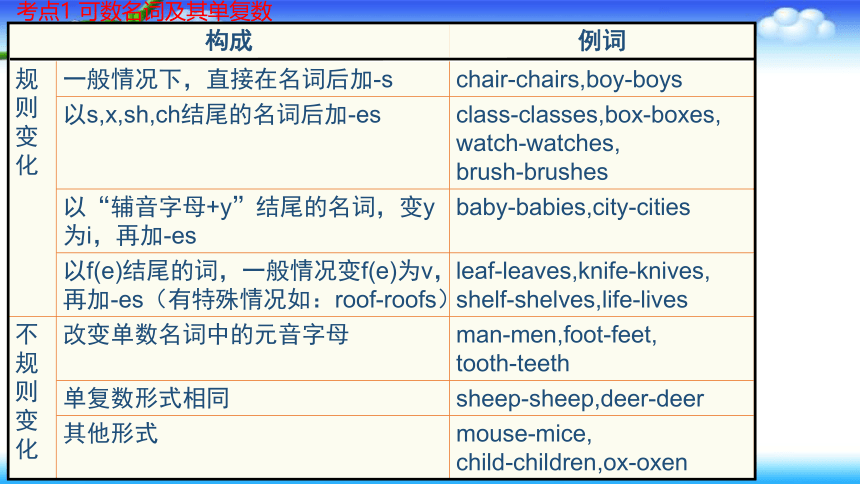
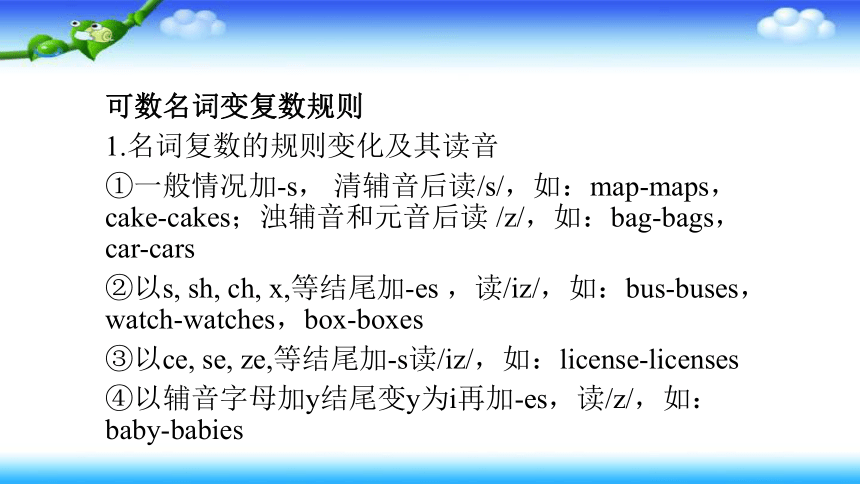
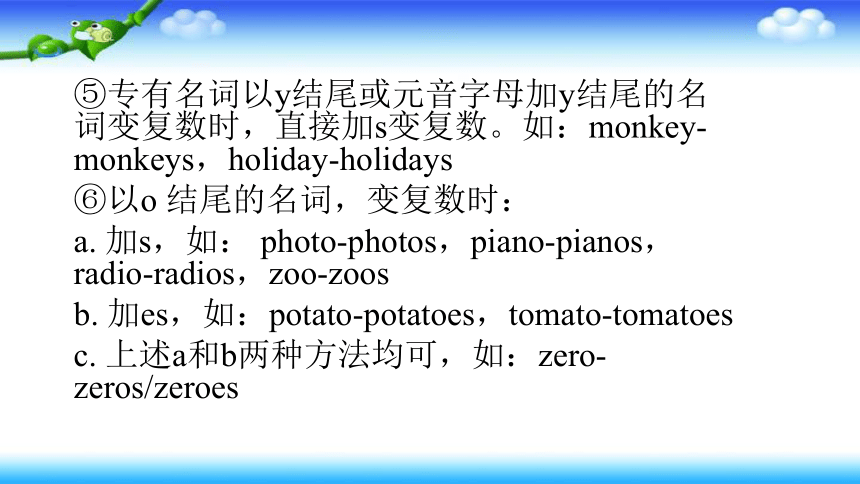
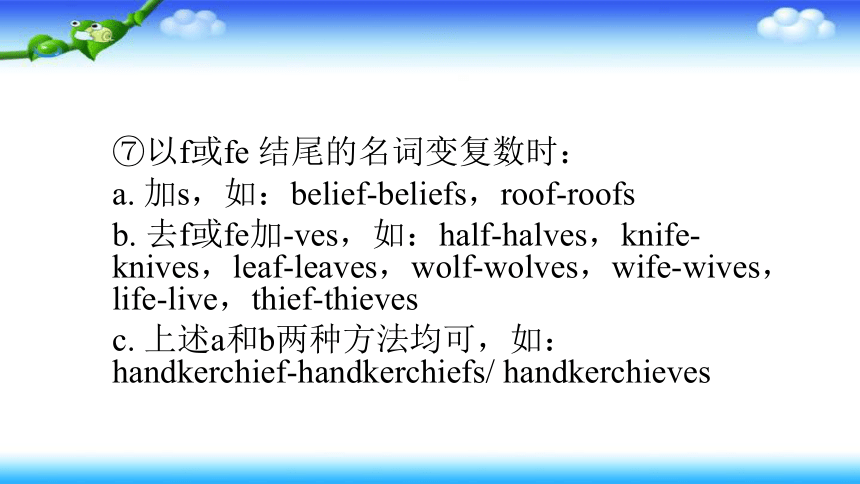

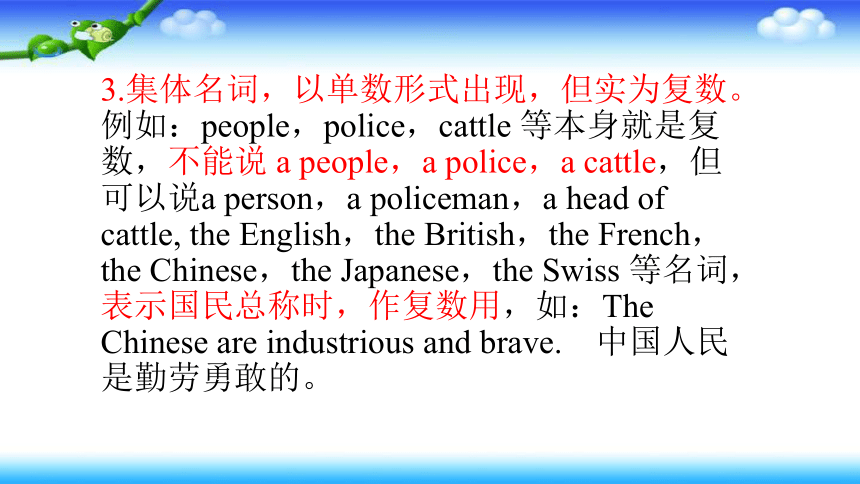
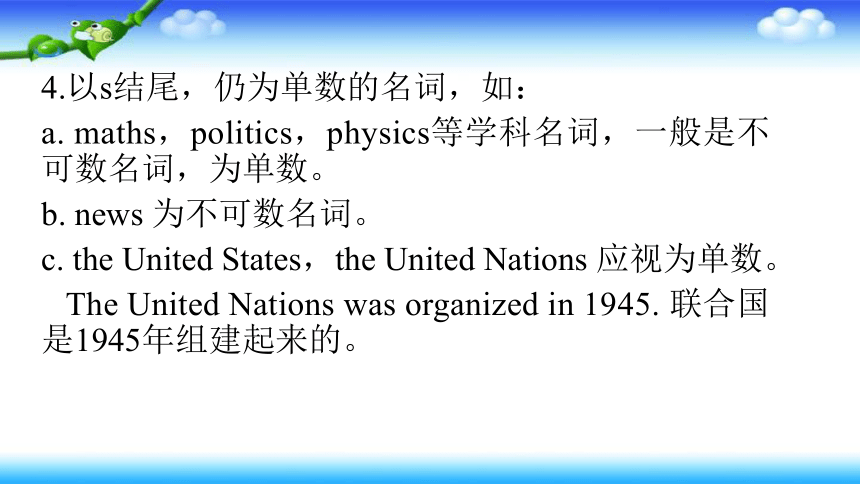

文档简介
名词
名词
专有名词:特定的人,地点等.
例:New York, Yao Ming
普通名词
可数名词
不可数名词
能够以数计算的事物的名词
不能以数计算的事物的名词
单数名词
复数名词
?
例:液体,气体等。milk, water, air…
例:pen, student, flowers…
普通名词:指一般的人,事物等. 例:apple, doctor
看到名词
可数
不可数
单数
复数
规则变化
不规则变化
特殊变化
做题思路
名词的分类
名词分为可数名词和不可数名词
不可数名词没有复数形式,也不能在其前面加a或an
表示数量时应在其前加量词,如:a bottle of water,two bags of rice,a piece of bread
考点1 可数名词及其单复数
{284E427A-3D55-4303-BF80-6455036E1DE7}构成
例词
规
则
变
化
一般情况下,直接在名词后加-s
chair-chairs,boy-boys
以s,x,sh,ch结尾的名词后加-es
class-classes,box-boxes,
watch-watches,
brush-brushes
以“辅音字母+y”结尾的名词,变y为i,再加-es
baby-babies,city-cities
以f(e)结尾的词,一般情况变f(e)为v,再加-es(有特殊情况如:roof-roofs)
leaf-leaves,knife-knives,
shelf-shelves,life-lives
不
规
则
变
化
改变单数名词中的元音字母
man-men,foot-feet,
tooth-teeth
单复数形式相同
sheep-sheep,deer-deer
其他形式
mouse-mice,
child-children,ox-oxen
可数名词变复数规则
1.名词复数的规则变化及其读音
①一般情况加-s, 清辅音后读/s/,如:map-maps,cake-cakes;浊辅音和元音后读 /z/,如:bag-bags,car-cars
②以s, sh, ch, x,等结尾加-es ,读/iz/,如:bus-buses,watch-watches,box-boxes
③以ce, se, ze,等结尾加-s读/iz/,如:license-licenses
④以辅音字母加y结尾变y为i再加-es,读/z/,如:baby-babies
⑤专有名词以y结尾或元音字母加y结尾的名词变复数时,直接加s变复数。如:monkey-monkeys,holiday-holidays
⑥以o 结尾的名词,变复数时:
a. 加s,如: photo-photos,piano-pianos,radio-radios,zoo-zoos
b. 加es,如:potato-potatoes,tomato-tomatoes
c. 上述a和b两种方法均可,如:zero-zeros/zeroes
⑦以f或fe 结尾的名词变复数时:
a. 加s,如:belief-beliefs,roof-roofs
b. 去f或fe加-ves,如:half-halves,knife-knives,leaf-leaves,wolf-wolves,wife-wives,life-live,thief-thieves
c. 上述a和b两种方法均可,如:handkerchief-handkerchiefs/ handkerchieves
1.child-children,foot-feet,tooth-teeth,mouse-mice,man-men,woman-women
注意:由一个词加 man 或 woman构成的合成词,其复数形式也是 men 和women,如:an Englishman-two Englishmen;但German不是合成词,故复数形式为Germans;Bowman是姓,其复数是the Bowmans。
2.单复同形,如deer,sheep,fish,Chinese,Japanese ,yuan。但除人民币的元、角、分外,美元、英镑、法郎等都有复数形式。如:a dollar-two dollars;a metre-two metres
名词复数的不规则变化
3.集体名词,以单数形式出现,但实为复数。例如:people,police,cattle 等本身就是复数,不能说 a people,a police,a cattle,但可以说a person,a policeman,a head of cattle, the English,the British,the French,the Chinese,the Japanese,the Swiss 等名词,表示国民总称时,作复数用,如:The Chinese are industrious and brave. 中国人民是勤劳勇敢的。
4.以s结尾,仍为单数的名词,如:
a. maths,politics,physics等学科名词,一般是不可数名词,为单数。
b. news 为不可数名词。
c. the United States,the United Nations 应视为单数。
The United Nations was organized in 1945. 联合国是1945年组建起来的。
d. 以复数形式出现的书名,剧名,报纸,杂志名,也可视为单数。例如:
The Arabian Nights is a very interesting storybook. 《一千零一夜》是一本非常有趣的故事书。
5.表示由两部分构成的东西,如:glasses(眼镜),trousers,clothes等,若表达具体数目,要借助数量词 pair(对,双);suit(套)
不同国籍人的单复数
中国人 the Chinese 单数a Chinese 复数 two Chinese
瑞士人 the Swiss 单数a Swiss 复数 two Swiss
澳大利亚人the Australians单数an Australian 复数two Australians
俄国人 the Russians 单数a Russian 复数two Russians
意大利人 the Italians 单数an Italian 复数two Italians
希腊人 the Greek 单数a Greek 复数two Greeks
知识拓展
不同国籍人的单复数
法国人 the French 单数a Frenchman 复数two Frenchmen
日本人 the Japanese 单数a Japanese 复数two Japanese
美国人 the Americans 单数an American 复数two Americans
印度人 the Indians 单数an Indian 复数two Indians
加拿大人 the Canadians 单数a Canadian 复数two Canadians
德国人 the Germans 单数a Germans 复数two Germans
英国人 the English 单数an Englishman 复数two Englishmen
瑞典人 the Swedish 单数a Swede 复数two Swedes
不同国籍人的单复数
名词单数变复数的发音规则
{5940675A-B579-460E-94D1-54222C63F5DA}情况
构成方法
读音规则
例词
一般情况
词尾加-s
(1)清辅音后读/s/
maps , books , boats
(2)在浊辅音和元音后读/z/
verbs , birds ,bags , kings , hills , names , pens , cars , trees
名词单数变复数的发音规则
{5940675A-B579-460E-94D1-54222C63F5DA}情况
构成方法
读音规则
例词
以-s , -x,
-sh , -ch , 结尾的名词
词尾加-es
读/iz/
buses , watches , wishes , boxes
以-o结尾的名词
词尾加-s或-es
读/z/
radios , heroes , potatoes
以辅音字母+y结尾的名词
变y为i加-es
读/iz/
cities , babies
以f或fe结尾的名词
变f或fe为v,再加es
读/vz/
knives , leaves
名词的所有格,表示名词的所有关系,有两种形式:
其一是由名词后加-'s构成,多用来表示有生命的人或物;其二是由介词of加名词构成,多用来表示无生命的东西(包括植物)。
考点2 名词所有格
名词后加-'s的所有格的构成方法:
1)单数名词后加-'s,单数名词以s结尾的后面加-'
如:Tom's dog(汤姆的狗),Thomas' brother(托马斯的哥哥)
2)复数名词以s结尾的后加-',不以s结尾的后加-'s
如:the students' reading room(学生阅览室),women's clothes(女装)。
3)复合名词在最后一个名词后面加-'s
如:the editor-in-chief's office(主编办公室),
my brother-in-law's friend(我妹夫的朋友)
4)两个以上名词共同的所有格表示共同所有,或两个以上名词各自的所有格连用表示各自所有时在名词后加-'s。
如: John and Mary's school(约翰和玛丽的学校)(同在一校)
John's and Mary's schools(约翰的学校和玛丽的学校)(两所学校)
注:
1)名词后加-'s用来表示有生命的人或物。如:
Mr. Brown is Lily's uncle. 布朗先生是莉莉的叔叔。
The dog's tail is short. 这条狗的尾巴短。
2)在表示时间、距离、重量、价格、国家、团体或城市时也用名词加-'s来表示所有关系。如:
a day's work(一天的工作),two miles' distance(两英里的距离),Japan's industry(日本的工业)
3)拟人化的非生物名词在表示所有关系时用名词后加-'s来表示。如:world's history(世界历史),fortune's favorite(幸运的宠儿)。
4)名词在上文中已出现,被名词的所有格修饰的名词常省略时名词后加-'s。如:
The computer is not mine, but Mr. Li's.
这台电脑不是我的,是李先生的。
5)名词后加-'s的形式用于被所有格修饰的名词为house,shop,home,store等建筑物时名词一般被省略。如:
He stayed at his uncle's (house). 他待在他叔叔的家里。
6)若所有格修饰的名词与后面出现的名词重复,则可以将前者省略,此时第一个名词后加-'s。如:
Peter's (family) was a large family. 彼得的(家庭)是个大家庭。
7)凡不能加-'s的名词,一般都可以与of构成短语,来表示所有关系。无生命名词的所有格也可以这么用。如:
Does anyone know the title of the novel? 有谁知道这部小说的名字?
但有特殊情况:如果名词后面有一个较长定语,尽管名词表示有生命的东西,也可以用这种所有格形式。如:This is a photo of my parents.
名词所有格
( )1.(广东)Katherine was excited to receive a dozen of roses from her husband on ______ Day.
A.Woman
B.Women
C.Woman’s
D.Women’s
( )2.Tomorrow is ______.The students want to buy some flowers for their teachers.
A.Teacher Day
B.Teacher’s Day
C.Teachers’ Day
D.the Teachers Day
D
C
( )3.(广东)______ mothers both work in the same hospital.
A.Tim and Peter’s
B.Tim’s and Peter
C.Tim’s and Peter’s
D.Tim and Peter
( )4.This is ______ computer.
A.Ann’s and Tom
B.Ann and Tom’s
C.Ann and Tom
D.Ann’s and Tom’s
C
B
名词所有格
考点4 名词辨析
2.dinner与meal的区别
(1)dinner是指“正餐(午饭或晚饭)”或“宴会”。
(2)meal是指“一餐(一顿饭)”。
练习:①Let’s go and have _________ together.
②What time do you usually have your ____________?
dinner
meals
3.sound, voice, noise
(1)sound“声音”,指耳朵能听到的各种声音,多作可数名词。(2)voice“声音”,主要指人的声音。
(3)noise指“噪音”。 可以作可数名词,也可作不可数名词,词组有make a noise等。
练习:①I was waiting for the _________ of the other shoe!
②The teacher said in a loud_________,“Please keep silent!”
③But every night he heard the _______upstairs.
sound
voice
noise
4.job与work
都可译为“工作”、“劳动”。job,work是常用词,其区别:job是可数名词,work是不可数名词。
练习:
①She got a __________ of washing clothes.
②It takes a lot of _________ to build a building.
job
work
5.person,people与man的区别
这三个词有共同之处,都有“人”的意思,但也有不同之处。
(1)person是指“人”(男人或女人),有单数形式,也有复数形式。
(2)people是复数形式,指“人民;人们”,不能指一个人。
(3)man专指“男人”,也指“人类”(不用复数形式,不加冠词)。
练习:
①Two ___________ are waiting for you.
②He lived for the ______________ and died for the people.
③All __________ must follow me.
persons
people
men
7.table与desk
都可译为“桌子”,其区别:table通常用于吃饭,游乐等。desk用于读书或办公,并且大多附有抽屉,常被称为“书桌”、“课桌”、“办公桌”等。
练习:①We were at _________ when he arrived.
②There are many __________ in the classroom.
table
desks
8.floor与ground
两者都有“地面、地上”的含义。其区别:floor 一般指室内的地上、地板、地面,而ground常指室外的地面,也可泛指地球表面。
练习:①He was sitting on the ________ when I came in.
②The ______________ is wet now.It must have rained last night.
floor
ground
9.door与gate
都可译为“门”。其区别:
(1)door 一般指房子、房间、家具等的门,还可用于比喻意义。
(2)gate指围墙、栅栏、篱笆等的开口处。
练习:①Close the ________ when you go out.
②He walked through the ________ into the garden.
door
gate
10.road,way, street
(1)road指“公路;马路”,指两侧之间可以通行人或车辆的大道。“在马路上”一般用on the road。“穿过马路”用cross the road(或go across the road)。
(2)way意为“路线;路途;方法”等,统指从一地到另一地的路途。常用固定词组有in this way(用这种方式);on the way to(在去……的路上);get in the way of(挡道)等。
(3)street表示“街道”,其两边有建筑物。“在街上”一般用in the street。“穿过街道”一般用go through the street。
练习:①Excuse me,can you tell me the___________ to the post office?
②When he went home, he saw an old woman lying in the____________.
③The___________ in this village is wider than before.
way
street
road
11.family, home
(1)family表示“家;家庭”,也可指全体家庭成员。
(2)home意为“家”,带有眷恋等感彩。
练习:①Tom has a big___________.There are six people in his ____________.
②She has been in Shenzhen for 10 years.Shenzhen has become her second __________.
family
family
home
12.idea, advice
(1)idea表示“主意”,是可数名词。 例如:a good idea一个好主意
(2)advice表示“建议”,“忠告”,是不可数名词。例如:a piece of advice 一个忠告(一个建议)
练习:①Can you give me some_________ on how to learn English well?
②He has got a good__________ to deal with his old books.
advice
idea
课堂小测
用所给名词的适当形式填空。
1. Are there any________(peach) on the table?
2. They are some young_________(woman).
3. The_________(children) is playing in the garden.
4. Some________(goose) are swimming in the river.
5. Would you like some________(fish)?
6. How many________(radio) can you see on the bookcase?
7. Are there any_______(boy) in the library?
8. One policeman caught three_______(thief) yesterday.
peaches
women
child
geese
fish
radios
boys
thieves
根据汉语提示完成句子。
1.?_________________(李明的父母) work?in?a?big?hospital.?
2.?This?is?_______________________(我妹妹的语文书).
3.?_________________________(Lucy 和Lily的卧室)?are?very?nice.?
4.?______________________________(王平和王明的父亲)?is?a?hotel?manager.?
5.They?are?__________________________(Peter?和Sam的老师).?
6.?________________(教师节)?is?on?September?10th?.?
7.?__________________________(学生们的桌椅)?are?very?new.?
8.?We?are?very?happy?on?________________(儿童节).?
9.?He?is?in?________________(老师的办公室)?now.?
Li Ming’s parents
My sister’s Chinese book
Lucy’s and Lily’s bedrooms
Wang Ping and Wang Ming’s dad
Peter’s and Sam’s teachers
Teachers’ Day
Students’ desks and chairs
Children’s Day
teachers’ office
根据汉语提示完成 句子。
10.??Please?open?___________________________(教室的门).?
11.?_______________(赵敏的鞋)?are?white.?
12.?_________________________(Mary和Sarah的学校)?is?big?and?new.?
13.?__________________________(John和Sally的母亲)?are?American.?
14.?___________________________(Tony哥哥的电脑)?is?broken.?
15.?________________(妇女节)?is on?March?8th.?
16.?Are?these?______________(男生们的书包)???
17.?That?is?__________________________(Tom和李雷的教室).?
the door of the classroom
Zhao Min’s shoes
Mary and Sarah’s school
John’s and Sally’s mothers
Tony’s brother’s computer
Women’s Day
boys’ bags
Tom and Li Lei’s classroom
根据所给单词的正确形式填空:
1.Different people may have different _____. (idea)
2. I often go to work on . (foot)
3. I know one of the . (boy)
4. Mr. Brown is wearing a pair of . (glass)
ideas
foot
boys
glasses
5. Please give them their _______ . (photo)
6. Are there any_________in the box? (watch)
7. There are twelve _______in a year. (month)
photos
watches
months
( ) 1. Please give me ______ paper.?
A. one B. a piece C. a D. a piece of
( ) 2. This table is made of_______.
A. many glass B. some glasses C. glasses D. glass
( ) 3.Bill runs fast. He won the? _____ 800-metre race yesterday.
A.boys B.boys’ C.boy D.boy‘s .
( ) 4. Some ______ came to our school for a visit that day.
A. Germans B. Germen C. Germany D. Germanies
( ) 5. In the picture there are many______ and two_______.?
A. sheeps; foxes B. sheeps; foxes
C. sheep; foxes D. sheep;foxs
D
D
B
A
C
选择填空。
7.This is my dress. That one is _______.
A. Mary B. Mary’s C. sister D. mother
8.Every morning Mr. Smith takes a _____to his office.
A. 20 minutes walk B. 20 minute’s walk
C. 20-minutes walk D. 20-minute walk
9.Where is ______ sweater ? I can’t see it.
A. Lucy B. Lucys C. Lucy’s D.Lucys'
10.______ mothers made them have piano lessons.
A. Peter and B. Peter’s and Anne’s
C. Peter’s and Anne D. Peter and Anne’s
11.The room on the right is ________.
A. her B. she C. Lucy’s D. Lucy
12.We’ll have a ____________ holiday.
What about going to the West Lake?
A. two days B. two-day C. two-days D. two-days’
B
D
C
B
C
B
13.The market isn’t far from here. It’s only bicycle ride.
A. half an hours’ B. half an hour’s
C. half an hour D. an hour and a half
14.Where’s your father ? At ______.
A. Mr. Green’s B. Mr. Green C. the Mr. Green’s
15.The twin brothers always put small presents in _____stockings on Christmas Day.
A. each other’s B. each other
C. each others D. each others’
16.My father will have a ____ holiday next month. He’ll take me to Qingdao.
A. ten days B. ten days’ C. ten-days D. ten day’s
17.-Where have you been these days?
-I have been to Bei Daihe with a friend ____.
A. in Chinese B. of Japan
C. of American’s D. from Canada
B
A
A
B
D
一、写出下列名词的单数或复数形式。
bus _____ sheep _____ woman_____ dress______ story ______ watch _______
pencil-box ____________ tomato________
apple ______ tree _____ stamp_______ baby______ tooth______ student________ star_____
buses
sheep
women
dresses
stories
watches
pencil-boxes
tomatoes
apples
trees
stamps
babies
teeth
students
stars
一、写出下列名词的单数或复数形式。
family _______ farmer _______
month_______ photo _______ fish____ peach _______ policeman ________ knife______ box _____ shelf ______ man ______ child______ leaf ______ zoo____ sheep _______
families
farmers
month
photos
fish
peaches
policemen
knives
boxes
shelves
men
children
leaves
zoos
sheep
名词
专有名词:特定的人,地点等.
例:New York, Yao Ming
普通名词
可数名词
不可数名词
能够以数计算的事物的名词
不能以数计算的事物的名词
单数名词
复数名词
?
例:液体,气体等。milk, water, air…
例:pen, student, flowers…
普通名词:指一般的人,事物等. 例:apple, doctor
看到名词
可数
不可数
单数
复数
规则变化
不规则变化
特殊变化
做题思路
名词的分类
名词分为可数名词和不可数名词
不可数名词没有复数形式,也不能在其前面加a或an
表示数量时应在其前加量词,如:a bottle of water,two bags of rice,a piece of bread
考点1 可数名词及其单复数
{284E427A-3D55-4303-BF80-6455036E1DE7}构成
例词
规
则
变
化
一般情况下,直接在名词后加-s
chair-chairs,boy-boys
以s,x,sh,ch结尾的名词后加-es
class-classes,box-boxes,
watch-watches,
brush-brushes
以“辅音字母+y”结尾的名词,变y为i,再加-es
baby-babies,city-cities
以f(e)结尾的词,一般情况变f(e)为v,再加-es(有特殊情况如:roof-roofs)
leaf-leaves,knife-knives,
shelf-shelves,life-lives
不
规
则
变
化
改变单数名词中的元音字母
man-men,foot-feet,
tooth-teeth
单复数形式相同
sheep-sheep,deer-deer
其他形式
mouse-mice,
child-children,ox-oxen
可数名词变复数规则
1.名词复数的规则变化及其读音
①一般情况加-s, 清辅音后读/s/,如:map-maps,cake-cakes;浊辅音和元音后读 /z/,如:bag-bags,car-cars
②以s, sh, ch, x,等结尾加-es ,读/iz/,如:bus-buses,watch-watches,box-boxes
③以ce, se, ze,等结尾加-s读/iz/,如:license-licenses
④以辅音字母加y结尾变y为i再加-es,读/z/,如:baby-babies
⑤专有名词以y结尾或元音字母加y结尾的名词变复数时,直接加s变复数。如:monkey-monkeys,holiday-holidays
⑥以o 结尾的名词,变复数时:
a. 加s,如: photo-photos,piano-pianos,radio-radios,zoo-zoos
b. 加es,如:potato-potatoes,tomato-tomatoes
c. 上述a和b两种方法均可,如:zero-zeros/zeroes
⑦以f或fe 结尾的名词变复数时:
a. 加s,如:belief-beliefs,roof-roofs
b. 去f或fe加-ves,如:half-halves,knife-knives,leaf-leaves,wolf-wolves,wife-wives,life-live,thief-thieves
c. 上述a和b两种方法均可,如:handkerchief-handkerchiefs/ handkerchieves
1.child-children,foot-feet,tooth-teeth,mouse-mice,man-men,woman-women
注意:由一个词加 man 或 woman构成的合成词,其复数形式也是 men 和women,如:an Englishman-two Englishmen;但German不是合成词,故复数形式为Germans;Bowman是姓,其复数是the Bowmans。
2.单复同形,如deer,sheep,fish,Chinese,Japanese ,yuan。但除人民币的元、角、分外,美元、英镑、法郎等都有复数形式。如:a dollar-two dollars;a metre-two metres
名词复数的不规则变化
3.集体名词,以单数形式出现,但实为复数。例如:people,police,cattle 等本身就是复数,不能说 a people,a police,a cattle,但可以说a person,a policeman,a head of cattle, the English,the British,the French,the Chinese,the Japanese,the Swiss 等名词,表示国民总称时,作复数用,如:The Chinese are industrious and brave. 中国人民是勤劳勇敢的。
4.以s结尾,仍为单数的名词,如:
a. maths,politics,physics等学科名词,一般是不可数名词,为单数。
b. news 为不可数名词。
c. the United States,the United Nations 应视为单数。
The United Nations was organized in 1945. 联合国是1945年组建起来的。
d. 以复数形式出现的书名,剧名,报纸,杂志名,也可视为单数。例如:
The Arabian Nights is a very interesting storybook. 《一千零一夜》是一本非常有趣的故事书。
5.表示由两部分构成的东西,如:glasses(眼镜),trousers,clothes等,若表达具体数目,要借助数量词 pair(对,双);suit(套)
不同国籍人的单复数
中国人 the Chinese 单数a Chinese 复数 two Chinese
瑞士人 the Swiss 单数a Swiss 复数 two Swiss
澳大利亚人the Australians单数an Australian 复数two Australians
俄国人 the Russians 单数a Russian 复数two Russians
意大利人 the Italians 单数an Italian 复数two Italians
希腊人 the Greek 单数a Greek 复数two Greeks
知识拓展
不同国籍人的单复数
法国人 the French 单数a Frenchman 复数two Frenchmen
日本人 the Japanese 单数a Japanese 复数two Japanese
美国人 the Americans 单数an American 复数two Americans
印度人 the Indians 单数an Indian 复数two Indians
加拿大人 the Canadians 单数a Canadian 复数two Canadians
德国人 the Germans 单数a Germans 复数two Germans
英国人 the English 单数an Englishman 复数two Englishmen
瑞典人 the Swedish 单数a Swede 复数two Swedes
不同国籍人的单复数
名词单数变复数的发音规则
{5940675A-B579-460E-94D1-54222C63F5DA}情况
构成方法
读音规则
例词
一般情况
词尾加-s
(1)清辅音后读/s/
maps , books , boats
(2)在浊辅音和元音后读/z/
verbs , birds ,bags , kings , hills , names , pens , cars , trees
名词单数变复数的发音规则
{5940675A-B579-460E-94D1-54222C63F5DA}情况
构成方法
读音规则
例词
以-s , -x,
-sh , -ch , 结尾的名词
词尾加-es
读/iz/
buses , watches , wishes , boxes
以-o结尾的名词
词尾加-s或-es
读/z/
radios , heroes , potatoes
以辅音字母+y结尾的名词
变y为i加-es
读/iz/
cities , babies
以f或fe结尾的名词
变f或fe为v,再加es
读/vz/
knives , leaves
名词的所有格,表示名词的所有关系,有两种形式:
其一是由名词后加-'s构成,多用来表示有生命的人或物;其二是由介词of加名词构成,多用来表示无生命的东西(包括植物)。
考点2 名词所有格
名词后加-'s的所有格的构成方法:
1)单数名词后加-'s,单数名词以s结尾的后面加-'
如:Tom's dog(汤姆的狗),Thomas' brother(托马斯的哥哥)
2)复数名词以s结尾的后加-',不以s结尾的后加-'s
如:the students' reading room(学生阅览室),women's clothes(女装)。
3)复合名词在最后一个名词后面加-'s
如:the editor-in-chief's office(主编办公室),
my brother-in-law's friend(我妹夫的朋友)
4)两个以上名词共同的所有格表示共同所有,或两个以上名词各自的所有格连用表示各自所有时在名词后加-'s。
如: John and Mary's school(约翰和玛丽的学校)(同在一校)
John's and Mary's schools(约翰的学校和玛丽的学校)(两所学校)
注:
1)名词后加-'s用来表示有生命的人或物。如:
Mr. Brown is Lily's uncle. 布朗先生是莉莉的叔叔。
The dog's tail is short. 这条狗的尾巴短。
2)在表示时间、距离、重量、价格、国家、团体或城市时也用名词加-'s来表示所有关系。如:
a day's work(一天的工作),two miles' distance(两英里的距离),Japan's industry(日本的工业)
3)拟人化的非生物名词在表示所有关系时用名词后加-'s来表示。如:world's history(世界历史),fortune's favorite(幸运的宠儿)。
4)名词在上文中已出现,被名词的所有格修饰的名词常省略时名词后加-'s。如:
The computer is not mine, but Mr. Li's.
这台电脑不是我的,是李先生的。
5)名词后加-'s的形式用于被所有格修饰的名词为house,shop,home,store等建筑物时名词一般被省略。如:
He stayed at his uncle's (house). 他待在他叔叔的家里。
6)若所有格修饰的名词与后面出现的名词重复,则可以将前者省略,此时第一个名词后加-'s。如:
Peter's (family) was a large family. 彼得的(家庭)是个大家庭。
7)凡不能加-'s的名词,一般都可以与of构成短语,来表示所有关系。无生命名词的所有格也可以这么用。如:
Does anyone know the title of the novel? 有谁知道这部小说的名字?
但有特殊情况:如果名词后面有一个较长定语,尽管名词表示有生命的东西,也可以用这种所有格形式。如:This is a photo of my parents.
名词所有格
( )1.(广东)Katherine was excited to receive a dozen of roses from her husband on ______ Day.
A.Woman
B.Women
C.Woman’s
D.Women’s
( )2.Tomorrow is ______.The students want to buy some flowers for their teachers.
A.Teacher Day
B.Teacher’s Day
C.Teachers’ Day
D.the Teachers Day
D
C
( )3.(广东)______ mothers both work in the same hospital.
A.Tim and Peter’s
B.Tim’s and Peter
C.Tim’s and Peter’s
D.Tim and Peter
( )4.This is ______ computer.
A.Ann’s and Tom
B.Ann and Tom’s
C.Ann and Tom
D.Ann’s and Tom’s
C
B
名词所有格
考点4 名词辨析
2.dinner与meal的区别
(1)dinner是指“正餐(午饭或晚饭)”或“宴会”。
(2)meal是指“一餐(一顿饭)”。
练习:①Let’s go and have _________ together.
②What time do you usually have your ____________?
dinner
meals
3.sound, voice, noise
(1)sound“声音”,指耳朵能听到的各种声音,多作可数名词。(2)voice“声音”,主要指人的声音。
(3)noise指“噪音”。 可以作可数名词,也可作不可数名词,词组有make a noise等。
练习:①I was waiting for the _________ of the other shoe!
②The teacher said in a loud_________,“Please keep silent!”
③But every night he heard the _______upstairs.
sound
voice
noise
4.job与work
都可译为“工作”、“劳动”。job,work是常用词,其区别:job是可数名词,work是不可数名词。
练习:
①She got a __________ of washing clothes.
②It takes a lot of _________ to build a building.
job
work
5.person,people与man的区别
这三个词有共同之处,都有“人”的意思,但也有不同之处。
(1)person是指“人”(男人或女人),有单数形式,也有复数形式。
(2)people是复数形式,指“人民;人们”,不能指一个人。
(3)man专指“男人”,也指“人类”(不用复数形式,不加冠词)。
练习:
①Two ___________ are waiting for you.
②He lived for the ______________ and died for the people.
③All __________ must follow me.
persons
people
men
7.table与desk
都可译为“桌子”,其区别:table通常用于吃饭,游乐等。desk用于读书或办公,并且大多附有抽屉,常被称为“书桌”、“课桌”、“办公桌”等。
练习:①We were at _________ when he arrived.
②There are many __________ in the classroom.
table
desks
8.floor与ground
两者都有“地面、地上”的含义。其区别:floor 一般指室内的地上、地板、地面,而ground常指室外的地面,也可泛指地球表面。
练习:①He was sitting on the ________ when I came in.
②The ______________ is wet now.It must have rained last night.
floor
ground
9.door与gate
都可译为“门”。其区别:
(1)door 一般指房子、房间、家具等的门,还可用于比喻意义。
(2)gate指围墙、栅栏、篱笆等的开口处。
练习:①Close the ________ when you go out.
②He walked through the ________ into the garden.
door
gate
10.road,way, street
(1)road指“公路;马路”,指两侧之间可以通行人或车辆的大道。“在马路上”一般用on the road。“穿过马路”用cross the road(或go across the road)。
(2)way意为“路线;路途;方法”等,统指从一地到另一地的路途。常用固定词组有in this way(用这种方式);on the way to(在去……的路上);get in the way of(挡道)等。
(3)street表示“街道”,其两边有建筑物。“在街上”一般用in the street。“穿过街道”一般用go through the street。
练习:①Excuse me,can you tell me the___________ to the post office?
②When he went home, he saw an old woman lying in the____________.
③The___________ in this village is wider than before.
way
street
road
11.family, home
(1)family表示“家;家庭”,也可指全体家庭成员。
(2)home意为“家”,带有眷恋等感彩。
练习:①Tom has a big___________.There are six people in his ____________.
②She has been in Shenzhen for 10 years.Shenzhen has become her second __________.
family
family
home
12.idea, advice
(1)idea表示“主意”,是可数名词。 例如:a good idea一个好主意
(2)advice表示“建议”,“忠告”,是不可数名词。例如:a piece of advice 一个忠告(一个建议)
练习:①Can you give me some_________ on how to learn English well?
②He has got a good__________ to deal with his old books.
advice
idea
课堂小测
用所给名词的适当形式填空。
1. Are there any________(peach) on the table?
2. They are some young_________(woman).
3. The_________(children) is playing in the garden.
4. Some________(goose) are swimming in the river.
5. Would you like some________(fish)?
6. How many________(radio) can you see on the bookcase?
7. Are there any_______(boy) in the library?
8. One policeman caught three_______(thief) yesterday.
peaches
women
child
geese
fish
radios
boys
thieves
根据汉语提示完成句子。
1.?_________________(李明的父母) work?in?a?big?hospital.?
2.?This?is?_______________________(我妹妹的语文书).
3.?_________________________(Lucy 和Lily的卧室)?are?very?nice.?
4.?______________________________(王平和王明的父亲)?is?a?hotel?manager.?
5.They?are?__________________________(Peter?和Sam的老师).?
6.?________________(教师节)?is?on?September?10th?.?
7.?__________________________(学生们的桌椅)?are?very?new.?
8.?We?are?very?happy?on?________________(儿童节).?
9.?He?is?in?________________(老师的办公室)?now.?
Li Ming’s parents
My sister’s Chinese book
Lucy’s and Lily’s bedrooms
Wang Ping and Wang Ming’s dad
Peter’s and Sam’s teachers
Teachers’ Day
Students’ desks and chairs
Children’s Day
teachers’ office
根据汉语提示完成 句子。
10.??Please?open?___________________________(教室的门).?
11.?_______________(赵敏的鞋)?are?white.?
12.?_________________________(Mary和Sarah的学校)?is?big?and?new.?
13.?__________________________(John和Sally的母亲)?are?American.?
14.?___________________________(Tony哥哥的电脑)?is?broken.?
15.?________________(妇女节)?is on?March?8th.?
16.?Are?these?______________(男生们的书包)???
17.?That?is?__________________________(Tom和李雷的教室).?
the door of the classroom
Zhao Min’s shoes
Mary and Sarah’s school
John’s and Sally’s mothers
Tony’s brother’s computer
Women’s Day
boys’ bags
Tom and Li Lei’s classroom
根据所给单词的正确形式填空:
1.Different people may have different _____. (idea)
2. I often go to work on . (foot)
3. I know one of the . (boy)
4. Mr. Brown is wearing a pair of . (glass)
ideas
foot
boys
glasses
5. Please give them their _______ . (photo)
6. Are there any_________in the box? (watch)
7. There are twelve _______in a year. (month)
photos
watches
months
( ) 1. Please give me ______ paper.?
A. one B. a piece C. a D. a piece of
( ) 2. This table is made of_______.
A. many glass B. some glasses C. glasses D. glass
( ) 3.Bill runs fast. He won the? _____ 800-metre race yesterday.
A.boys B.boys’ C.boy D.boy‘s .
( ) 4. Some ______ came to our school for a visit that day.
A. Germans B. Germen C. Germany D. Germanies
( ) 5. In the picture there are many______ and two_______.?
A. sheeps; foxes B. sheeps; foxes
C. sheep; foxes D. sheep;foxs
D
D
B
A
C
选择填空。
7.This is my dress. That one is _______.
A. Mary B. Mary’s C. sister D. mother
8.Every morning Mr. Smith takes a _____to his office.
A. 20 minutes walk B. 20 minute’s walk
C. 20-minutes walk D. 20-minute walk
9.Where is ______ sweater ? I can’t see it.
A. Lucy B. Lucys C. Lucy’s D.Lucys'
10.______ mothers made them have piano lessons.
A. Peter and B. Peter’s and Anne’s
C. Peter’s and Anne D. Peter and Anne’s
11.The room on the right is ________.
A. her B. she C. Lucy’s D. Lucy
12.We’ll have a ____________ holiday.
What about going to the West Lake?
A. two days B. two-day C. two-days D. two-days’
B
D
C
B
C
B
13.The market isn’t far from here. It’s only bicycle ride.
A. half an hours’ B. half an hour’s
C. half an hour D. an hour and a half
14.Where’s your father ? At ______.
A. Mr. Green’s B. Mr. Green C. the Mr. Green’s
15.The twin brothers always put small presents in _____stockings on Christmas Day.
A. each other’s B. each other
C. each others D. each others’
16.My father will have a ____ holiday next month. He’ll take me to Qingdao.
A. ten days B. ten days’ C. ten-days D. ten day’s
17.-Where have you been these days?
-I have been to Bei Daihe with a friend ____.
A. in Chinese B. of Japan
C. of American’s D. from Canada
B
A
A
B
D
一、写出下列名词的单数或复数形式。
bus _____ sheep _____ woman_____ dress______ story ______ watch _______
pencil-box ____________ tomato________
apple ______ tree _____ stamp_______ baby______ tooth______ student________ star_____
buses
sheep
women
dresses
stories
watches
pencil-boxes
tomatoes
apples
trees
stamps
babies
teeth
students
stars
一、写出下列名词的单数或复数形式。
family _______ farmer _______
month_______ photo _______ fish____ peach _______ policeman ________ knife______ box _____ shelf ______ man ______ child______ leaf ______ zoo____ sheep _______
families
farmers
month
photos
fish
peaches
policemen
knives
boxes
shelves
men
children
leaves
zoos
sheep
